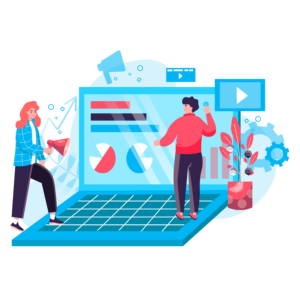Deciding where to allocate your marketing budget can significantly impact your business’s growth and success. Understanding the different avenues available—whether inbound vs. outbound marketing or digital vs. traditional channels—is crucial for making informed decisions. Let’s explore these options and the considerations involved in each.
Inbound vs. Outbound Marketing
Inbound Marketing: Inbound marketing focuses on attracting customers through valuable content and experiences tailored to their needs. This approach aims to pull prospects toward your brand naturally rather than pushing messages outwardly. Examples include content marketing, SEO, social media engagement, and email newsletters.
Pros of Inbound Marketing:
- Cost-Effective: Often provides a higher ROI over time compared to outbound.
- Builds Trust: Establishes authority and credibility by providing valuable content.
- Long-Term Benefits: Content continues to attract and engage prospects long after initial creation.
Cons of Inbound Marketing:
- Time-Intensive: Requires patience as results can take time to materialize.
- Competitive: Requires consistent effort to stand out in a crowded online space.
Outbound Marketing: Outbound marketing involves reaching out to potential customers through traditional advertising methods like TV commercials, radio ads, direct mail, and cold calling. Unlike inbound strategies, outbound marketing pushes messages out to a broader audience.
Pros of Outbound Marketing:
- Immediate Impact: Can generate quick results and brand visibility.
- Targeted Reach: Allows for precise targeting based on demographics and behaviors.
- Brand Recognition: Reinforces brand presence through repetition.
Cons of Outbound Marketing:
- High Costs: Can be expensive, especially for small businesses with limited budgets.
- Interruptive: Often viewed as intrusive or interruptive by consumers.
- Harder to Measure ROI: Results can be harder to track accurately compared to digital methods.
Digital vs. Traditional Marketing
Digital Marketing: Digital marketing utilizes online platforms and technologies to reach and engage with audiences. This includes tactics such as PPC advertising, social media marketing, content marketing, and email campaigns. Digital marketing offers precise targeting, real-time analytics, and the ability to adjust campaigns quickly based on performance metrics.
Pros of Digital Marketing:
- Targeted Audience: Allows for precise targeting based on demographics, interests, and behaviors.
- Measurable Results: Provides detailed analytics to track ROI and campaign effectiveness.
- Cost-Effective: Generally more cost-effective than traditional methods, especially for smaller budgets.
Cons of Digital Marketing:
- Saturation: High competition can make it challenging to stand out.
- Constant Evolution: Requires staying updated with technology and platform changes.
- Digital Fatigue: Consumers may ignore digital ads due to oversaturation.
Traditional Marketing: Traditional marketing encompasses offline methods like print ads, TV commercials, radio spots, billboards, and direct mail. While digital has become dominant, traditional methods still hold value for certain demographics and industries seeking broader brand visibility.
Pros of Traditional Marketing:
- Wide Reach: Reaches audiences who may not be online or actively engaged in digital platforms.
- Tangibility: Physical ads can leave a lasting impression and be more memorable.
- Established Credibility: Older demographics may trust traditional media more than digital ads.
Cons of Traditional Marketing:
- High Costs: Production and distribution costs can be prohibitive.
- Limited Targeting: Less precise audience targeting compared to digital methods.
- Difficult to Measure ROI: Tracking ROI can be more challenging compared to digital analytics.
Communication Over Visibility
Effective marketing isn’t just about being seen—it’s about communicating your message effectively to the right audience at the right time. Understanding your target market’s preferences and behaviors is crucial for choosing the most appropriate marketing channels.
Communication Starts with the concept; Who you speaking to, what service and message you are trying to deliver, your call to action etc.
Format: what format are you considering? This could be written text, photos, graphics, videos etc.
Identify & Deliver: now that you have your Message formatted in a way that can be understood. It is time to get it out to the world. Seems simple, right? Well, you’ll need to identify your audience first.
Identifying your audience: In terms of demographics, interests, age, location, etc. Then, What mediums they engage with – An older generation could be newspaper, AARP, radio etc. whereas younger generation would be Various social media networks, influencers, TV shows etc.
Delivery: In This day and age times are quite competitive, every business is fighting for your attention, it is hard to get a message through the static. Often times publishing is enough anymore, you have to pay to play. For instance, Facebook and Instagram has a massive network, but good luck getting your post in front of everyone without boosting, or paying to get eyes on your message. Even then people don’t want to be advertised to so, So if you find your message isn’t getting the results you wanted, you may want to go back and review the previous considerations in the article. That brings me to my next point, optimization!
Optimization
Search engine optimization is a hot buzz word and has been for well over a decade at this point. AB testing is another buzz word that you’ll hear if you work with a digital marketing agency who paid advertising for you. EssentiallyThe role of optimization is simple, you review performance and make adjustments based on data to increase results. Easier said than done, but it’s an important step that occurs after you’ve launched your well-thought-out campaign.
The Blended Approach
Given the pros and cons of each method, a blended approach often proves most effective. By combining inbound, outbound, and communicative strategies, businesses can maximize their reach while optimizing their marketing budget. This approach allows for flexibility, adaptation to market trends, and ensures a balanced presence across multiple channels.
In conclusion, the key to effective marketing lies in understanding your audience, leveraging the strengths of each marketing channel, and continuously evaluating and adjusting your strategies based on performance metrics. By taking a strategic, blended approach, businesses can achieve both visibility and meaningful engagement with their target audience.
For personalized insights and guidance on optimizing your marketing strategy, contact us at Syndicate Marketing. Let’s work together to elevate your brand and drive sustainable growth.







